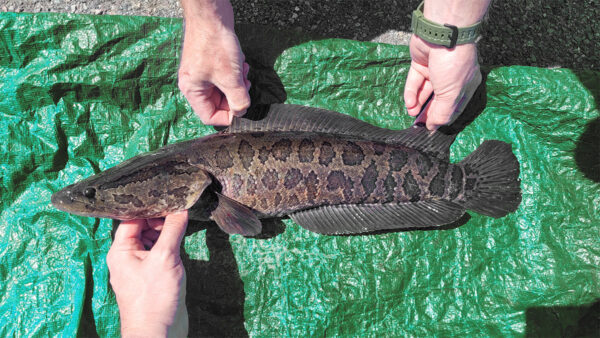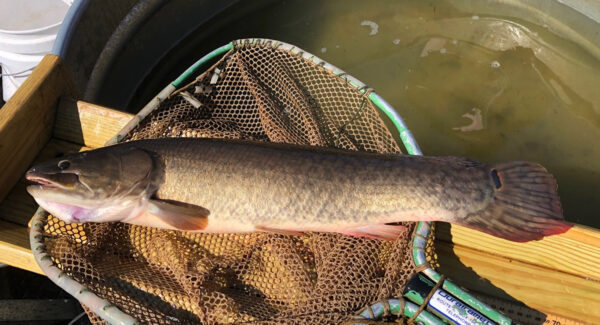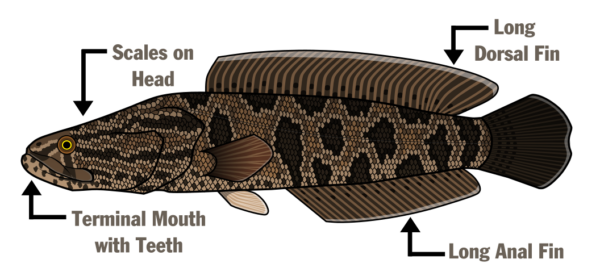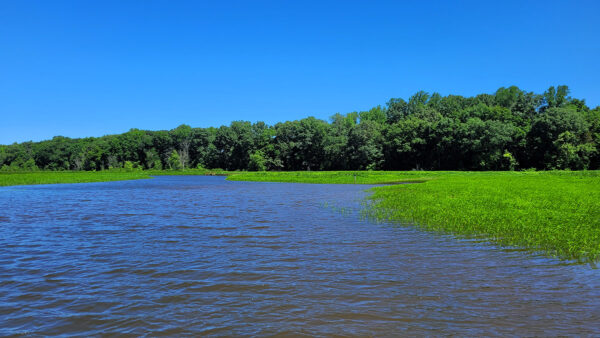An up-close look at a Northern Snakehead.
An Age-2 Northern Snakehead (top) and an Age-1 Northern Snakehead (bottom).
Fact File
Scientific Name: Channa argus
Classification: Fish, Order Anabantiformes, Family Channidae
Conservation Status:
- Nonindigenous Aquatic Nuisance Species
Size: Northern Snakehead can attain lengths to about 36 inches and weights of around 20 pounds in Virginia
Life Span: Northern Snakehead in Virginia live for about 8 years on average, but can occasionally live for up to 15 years
Distribution
The Northern Snakehead is native to eastern Asia but was first discovered within Virginia waters in 2004. Northern Snakehead now have established populations throughout much of the Potomac, Rappahannock, and smaller adjacent tidal watersheds, including numerous small impoundments. Isolated occurrences of Northern Snakehead have been documented within the James, Shenandoah, and York River basins as this invasive species continues to be spread by a combination of unlawful individuals and natural innate dispersal mechanisms.

Anglers are reminded that it is illegal to stock any species of fish into a public body of water without an authorization from the Virginia Department of Wildlife Resources. Additionally, it is illegal to import, possess, transport, sell, purchase, give, or receive a live Northern Snakehead in Virginia.
Anglers may legally practice catch-and-release or kill a Northern Snakehead at the location it was caught, and are encouraged to harvest and report the catch to DWR at (804) 367-2925. Northern Snakehead are excellent table fare, and may be safely consumed while adhering to local fish consumption advisories set forth by the Virginia Department of Health.
Anglers wishing to harvest a Northern Snakehead for consumption must dispatch the fish before transporting it by:
-
- Removing the head
- Separating the gill arches from the body
- Removing the internal organs
Identifying Characteristics

A dispatched Northern Snakehead prior to being processed for biological data.
- Elongate body shape with a long dorsal (top) fin and a long anal (bottom) fin
- Body color is often tan to dark brown
- A mouth full of sharp teeth
- An exaggerated underbite when the mouth is fully closed
- Snakelike mottling along the sides, often with black outlines
- Obvious scales throughout the head and body, almost reptilian in appearance
- Pelvic fins are almost directly beneath the pectoral fins
How to Discern from Similar Looking Species
Ruddy Bowfin Amia calva
- The anal (bottom) fin on a Ruddy Bowfin is not elongated
- Ruddy Bowfin do not have scales on the top of their head
- Ruddy Bowfin often have a spot near the tail

A Ruddy Bowfin. Note the short anal fin, spot on tail, and the lack of scales on the head. ©Photo by Scott Herrmann
American Eel Anguilla rostrata
- An American Eel has no visible scales
- An American Eel has a continuous dorsal, caudal, and anal fin

An American Eel. Note the lack of visible scales.
Channidae Characteristics and Anatomical Terms

Illustration by ©Makayla Haggard – DWR

Illustration by ©Makayla Haggard – DWR
Diet
Northern Snakehead are opportunistic ambush predators, often feeding by concealing themselves in the cover of aquatic vegetation until a prey item is within striking range. In Virginia, their diet has been found to mostly consist of various species of killifish and sunfishes, but they will consume other species of fish, as well as amphibians and small terrestrial wildlife when given the chance.
Habitat
Northern Snakehead thrive in sluggish waters with dense submerged aquatic vegetation, often atop silty or muddy flats. Because Northern Snakehead are obligate airbreathers, meaning they have the ability to repurpose atmospheric oxygen for breathing purposes, they can survive in low oxygen conditions in shallow backwaters.
Northern Snakehead Research in Virginia
Since the discovery of Northern Snakehead in Virginia in 2004, the Department of Wildlife Resources has been actively studying their distribution, diet, and ecological impact within Virginia waters. The most recent data collected by the Department of Wildlife Resources suggests that the relative abundance of Northern Snakehead has stabilized and declined in many waters where populations have been established longest in Virginia.
Although this is a positive sign for those particular locations, many of these ecosystems are large bodies of water that were already dominated by other introduced species of fish prior to the arrival of Northern Snakehead. The Virginia Department of Wildlife Resources remains concerned about the detrimental impacts the Northern Snakehead may have in other environments, and would like to remind all individuals that it is unlawful to possess and transport live Northern Snakehead.
Scientific Literature
- Isel, M.W. and J. S. Odenkirk. 2019. Evaluation of Northern Snakehead Diets in Virginia’s Tidal Rivers and Lakes. American Fisheries Society Symposium 89.
- Odenkirk, John S. 2018. The First International Snakehead Symposium: News from the Front(s). Fisheries 44: 123-128.
- Odenkirk, J.S., and M. W. Isel. 2016. Trends in abundance of Northern Snakeheads in Virginia tributaries of the Potomac River. Transactions of the American Fisheries Society 145: 687-692.
- Odenkirk, J., C. Lim, S. Owens, and M. Isel. 2014. Insight into age and growth of northern snakehead in the Potomac River. North American Journal of Fisheries Management 33:4, 773-776.
- Odenkirk, J. and S. Owens. 2007. Expansion of a northern snakehead population in the Potomac River system. Transactions of the American Fisheries Society 136:1633-1639.
- Odenkirk, J. and S. Owens. 2005. Northern Snakeheads in the tidal Potomac River system. Transactions of the American Fisheries Society 134: 1605-1609.
Available online from www.fisheries.org
Special Considerations
Northern Snakehead, and other members of the Channidae family of fishes are considered by the Commonwealth of Virginia to be a Nonindigenous Aquatic Nuisance Species.
A. No person shall knowingly import, possess, transport, sell, purchase, give, receive, or introduce into the Commonwealth any member of a species designated as a nonindigenous aquatic nuisance species without a permit from the Director issued pursuant to § 29.1-575.
B. Subsection A shall not apply to any person who (i) lawfully catches a snakehead fish of the family Channidae, (ii) subsequently kills such fish, and (iii) notifies the Department, as soon as practicable, of his actions.
C. Subsection A shall not apply to any Hazard Analysis and Critical Control Point (HACCP) plan (21 C.F.R. 120 et seq.) certified restaurant or retail market that purchases from an HACCP certified dealer or sells processed snakehead fish of the family Channidae.
Code of Virginia § 29.1-571.
Code of Virginia § 29.1-574. Prohibitions.
Misconceptions Regarding the Northern Snakehead
Myth: Northern Snakehead populations spread by migrating over land.
Fact: Northern Snakehead do not volitionally travel across land. They primarily spread through natural dispersion in aquatic environments, illegal transportation and stocking activities.
Myth: Northern Snakehead can live on land.
Fact: Northern Snakehead are obligate air-breathers, meaning they have the ability to temporarily utilize atmospheric oxygen. They cannot eat or survive long-term out of water.
Myth: Northern Snakehead can attack children or pets.
Fact: Northern Snakehead do not attack humans or small pets such as cats and dogs.

A Virginia angler shows a Northern Snakehead caught while fishing.
Last updated: March 19, 2025
The Virginia Department of Wildlife Resources Species Profile Database serves as a repository of information for Virginia’s fish and wildlife species. The database is managed and curated by the Wildlife Information and Environmental Services (WIES) program. Species profile data, distribution information, and photography is generated by the Virginia Department of Wildlife Resources, State and Federal agencies, Collection Permittees, and other trusted partners. This product is not suitable for legal, engineering, or surveying use. The Virginia Department of Wildlife Resources does not accept responsibility for any missing data, inaccuracies, or other errors which may exist. In accordance with the terms of service for this product, you agree to this disclaimer.


